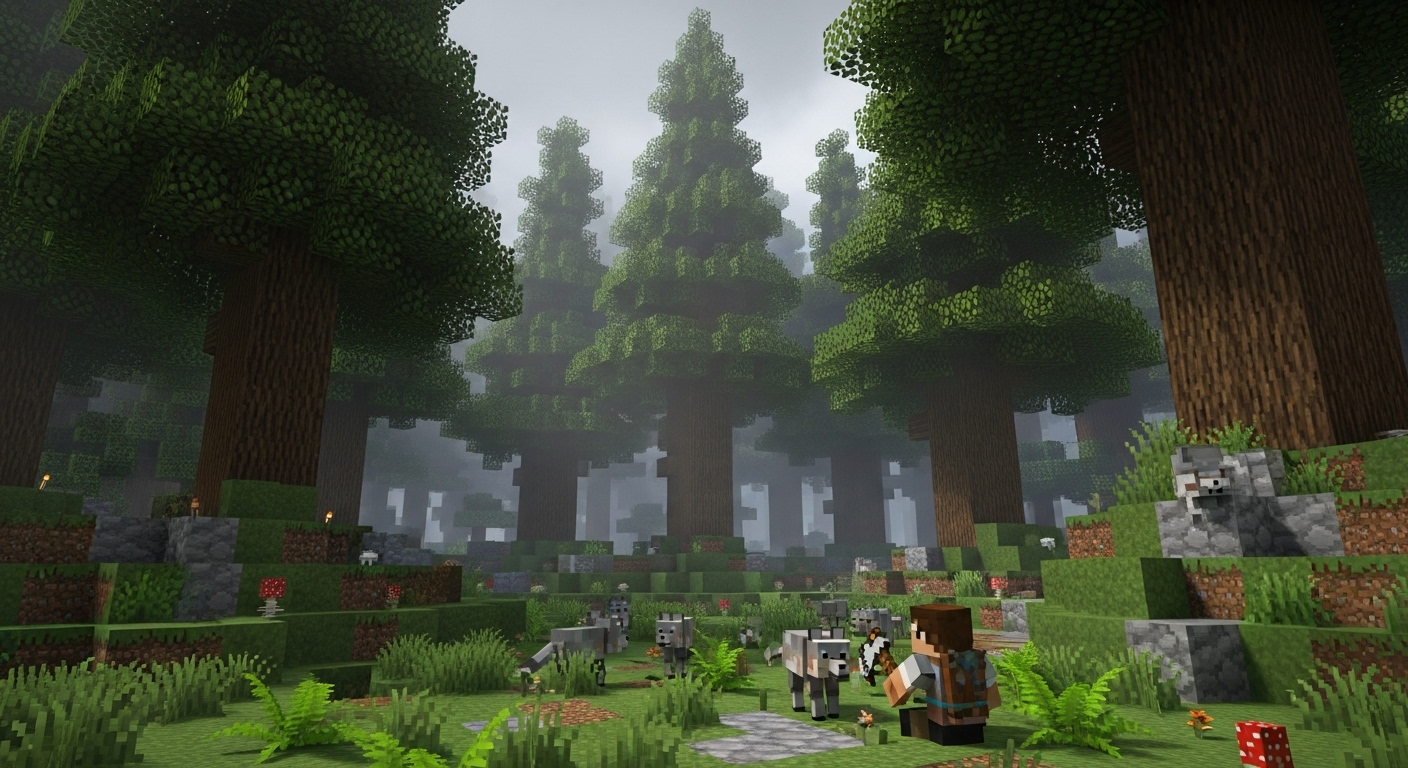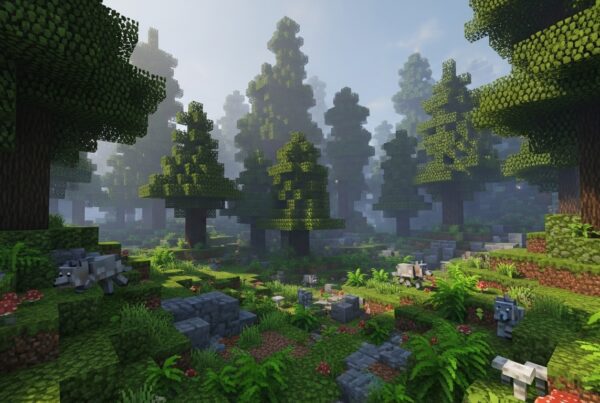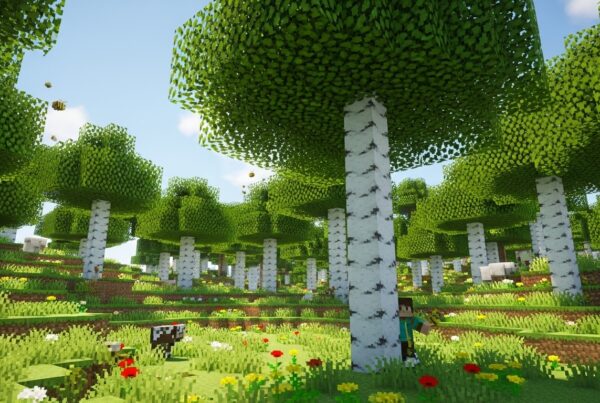The Old Growth Pine Taiga biome in Minecraft — previously known as the Mega Taiga — is one of the game’s most atmospheric and resource-rich environments. Characterized by its towering spruce trees, mossy cobblestone boulders, and podzol-covered ground, this ancient forest offers a unique combination of challenge, beauty, and survival potential.
As part of the Old Growth Taiga biome family, the Pine variant delivers a slightly brighter, more open atmosphere than its sister biome, the Old Growth Spruce Taiga — making it an ideal setting for exploration and rustic base-building.
How to Find the Old Growth Pine Taiga
The Old Growth Pine Taiga generates in cold Overworld climates, often at mid-to-high elevations and adjacent to snowy or mountainous regions. It’s less common than standard Taiga or Forest biomes, making it a rewarding discovery for explorers.
Where to find it:
- Appears between Y = 80–150 in temperate to cold zones.
- Common neighboring biomes: Old Growth Spruce Taiga, Taiga, Snowy Taiga, Grove, Jagged Peaks.
- Distinguishable by giant 2×2 spruce trees, podzol, and mossy stone boulders.
Command to locate the biome:
/locate biome minecraft:old_growth_pine_taiga
Pro Tip: Tools like Chunkbase’s Biome Finder can help pinpoint the biome’s coordinates quickly using your world seed.
Biome Characteristics and Terrain Features
The Old Growth Pine Taiga exudes an ancient, misty forest feel. Its terrain combines rolling hills, mossy boulders, and giant trees that create a sense of untouched wilderness.
Key terrain traits:
- Tree type: Giant spruce trees with 2×2 trunks, up to 30 blocks tall.
- Ground blocks: Podzol, coarse dirt, and mossy cobblestone.
- Light level: Naturally dim under the thick canopy.
- Weather: Rainy with snow at higher elevations.
- Temperature: 0.3
- Downfall: 0.8
- Humidity: High — supports lush underground growth.
This biome often generates above or around lush caves, making it an excellent surface marker for locating underground greenery and clay-rich cave systems.
Flora, Foliage, and Natural Blocks
The Old Growth Pine Taiga’s vegetation creates a dense, overgrown look that gives the biome its primeval character.
Common vegetation and resources:
- Spruce Trees (2×2 “Giant Pines”) – abundant spruce logs and saplings.
- Ferns and Large Ferns – fill the undergrowth.
- Sweet Berry Bushes – renewable food source (watch for thorn damage).
- Red and Brown Mushrooms – thrive on podzol, even in sunlight.
- Mossy Cobblestone Boulders – decorative stone formations scattered through the forest.
Unique ground materials:
- Podzol: Prevents grass spread and allows mushrooms to grow in light.
- Coarse Dirt: Adds rugged texture to terrain.
Tip for builders: Use Podzol and Mossy Cobblestone together for realistic nature-themed builds such as forest shrines, ruins, or overgrown pathways.
Underground Features & Lush Caves
A unique feature of the Old Growth Pine Taiga is that it frequently generates above Lush Caves. The biome’s high humidity and rich vegetation make it one of the most reliable surface indicators for finding these underground cave systems.
Why this matters:
- Lush Caves provide clay, moss, glow berries, and axolotls.
- Building a base here allows easy access to both wood (above) and lush resources (below).
- The transition between biomes creates naturally scenic cave entrances.
Mobs That Spawn Here
The Old Growth Pine Taiga offers a diverse ecosystem of passive and hostile mobs, with wolves being the biome’s signature species.
| Mob Type | Mob Name | Spawn Rate / Group Size | Notes |
|---|---|---|---|
| Passive | Wolves | Common (4 per group) | Tameable with bones — great survival companions. |
| Foxes | Uncommon (2 per group) | Spawn mainly at night. | |
| Rabbits | Rare | Usually white or brown variants. | |
| Sheep, Pigs | Occasional | Spawn in small clearings. | |
| Hostile | Zombies, Skeletons, Creepers, Spiders | Standard night spawns | More frequent under dense canopy. |
Because of the low light levels, hostile mobs can spawn even during early dusk. Lighting up paths and clearing brush is essential for safe survival play.
Structures and Points of Interest
Although this biome doesn’t have exclusive structures, several world-generated features can appear here:
- Trail Ruins – newly added archaeological structures that sometimes spawn in Old Growth Taigas, offering rare pottery sherds and loot.
- Ruined Portals – provide obsidian, gold, and Nether-related loot.
- Villages – may generate near borders shared with Taiga or Plains.
- Pillager Outposts – uncommon but possible on biome edges.
- Caves & Ravines – cut through the hilly terrain, often connecting directly to Lush Caves below.
Survival and Building Tips
The Old Growth Pine Taiga is both strategically valuable and visually stunning, ideal for players who like survival with a natural twist.
Survival Tips:
- Tame wolves early for protection — they spawn frequently and travel in packs.
- Collect podzol with Silk Touch for mushroom farming or decorative builds.
- Watch for berry bushes — they provide food but can hurt you on contact.
- Light up dark areas under the trees to prevent mob ambushes.
Building Ideas:
- Rustic log cabins or mountain lodges using spruce wood and stone.
- Treehouse villages connected by rope bridges.
- Underground bases leading into lush caves below.
- Ruined fortresses built from mossy cobblestone to match the biome’s aesthetic.
Comparison: Old Growth Pine Taiga vs Old Growth Spruce Taiga
| Feature | Old Growth Pine Taiga | Old Growth Spruce Taiga |
|---|---|---|
| Tree Type | Giant 2×2 Spruce Trees (Pine form) | Taller and denser Spruce Trees |
| Ground Cover | Podzol, Coarse Dirt, Mossy Cobblestone | Podzol, Coarse Dirt, Mossy Cobblestone |
| Atmosphere | Slightly brighter, more open | Darker, denser canopy |
| Underground Generation | High chance of Lush Caves | Moderate chance |
| Rarity | Uncommon | Slightly rarer |
| Best For | Resource gathering and open builds | Immersive exploration and deep forests |
Version History and Technical Details
| Version | Change |
|---|---|
| Java 1.7 (13w36a) | Added as Mega Taiga. |
| Java 1.13 | Renamed to Giant Tree Taiga. |
| Java 1.18 (Caves & Cliffs Part II) | Renamed to Old Growth Pine Taiga and updated world generation. |
| Bedrock 1.18 | Equivalent biome introduced. |
Technical Data (Java Edition):
- Biome ID: minecraft:old_growth_pine_taiga
- Category: Taiga
- Temperature: 0.3
- Downfall: 0.8
- Snowline: Y ≈ 200 ± 8
Atmosphere and Lore
According to Minecraft.net, the Old Growth Pine Taiga’s damp environment “allows for an endless cycle of growth, dieback, and regrowth.” This gives the biome a living, breathing quality — a place where ancient trees have stood for centuries, slowly reclaiming fallen logs with moss and fungi.
The mix of mist, dense foliage, and ambient wildlife creates one of Minecraft’s most immersive survival environments.
Fun Facts and Trivia
- Podzol is one of the few blocks where mushrooms grow in daylight.
- Wolves have a higher spawn rate here than in most other biomes.
- The biome’s humidity ensures lush caves almost always appear below it.
- It’s one of the few biomes featuring three ground block types (podzol, coarse dirt, mossy cobblestone) naturally.
- Perfect for Nordic, fantasy, or wilderness-themed builds thanks to its rugged, organic terrain.
Conclusion
The Old Growth Pine Taiga biome is a masterpiece of natural design — vast, ancient, and alive with subtle details. From its towering spruce trees to its underground lush caves, it combines the best of exploration, survival, and aesthetic appeal.
Whether you’re taming wolves, collecting podzol, or carving a home among the giant pines, this biome rewards players who appreciate both adventure and artistry in Minecraft’s wild landscapes.
Step beneath the canopy — and experience one of the most breathtaking biomes the Overworld has to offer.






